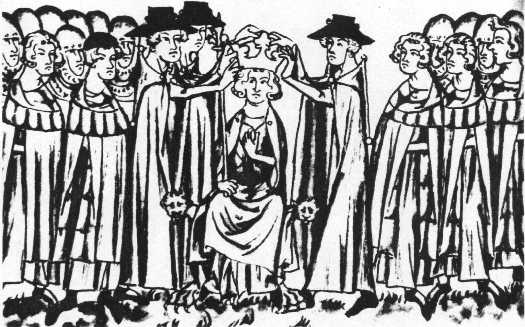
|
|
A medieval forerunner to the crest of J. V. Andreae Susanna Åkerman A medieval forerunner to the crest of J. V. Andreae Susanna Åkerman:  The family crest of J. V. Andreae consists of the cross of St. Andrew and four roses. Many take its symbolism to have inspired the creation of the name of the figure of Christian Rosencreutz in the Fama fraternitatis roseae crucis (1614), a text now generally held to have been written by Andreae. The family crest was designed by Johannes Valentin's grandfather Jakob Andreae, the reformation ideologue and defender of Luther's evangelical tradition. It has been argued that the design with roses and cross was inspired by Luther's personal crest consisting of a white rose with a red heart and cross in the middle. The cross of St. Andrew readily suggested itself to Jakob Andreae because of his family name.  It is, however, exciting to come across the very same crest in a suggestive context many centuries before. On a medal printed as "lvx ii" in the very beginning of vol. V of Dom Augustin Calmet's Histoire de Lorraine (Nancy, 1752) we find the crest of Henric of Luxemburg. It is described on p. cxlvii as "une croix de St. Andrée accompagnés de quatre roses". As one can plainly see the crest is identical to that of J. V. Andreae. Henric of Luxemburg was elected King of the Germans and Romans in 1308 and descended upon Italy to be invested with an iron crown as Holy Roman emperor in Milano in 1312.  After this initial success in uniting Italy against the influence of Pope Clemens V, a plan worked out with the aid of his cousin Thiebaud de Bar, Henric suddenly died in 1313. It is remarkable that Dante places him in the supreme realm reached at the end of the Divina Commedia. In canto xxx of the Paradiso (written around 1316) Dante sees him (in Mark Musa's translation) "under the gold of the eternal rose... in our vast white-robed consistory:" In that great chair already set with crown above it and which draws your eyes to it, before you summon to this nuptial feast, shall sit the soul, predestined emperor, of that Great Henry who one day will come to set straight Italy before her time.
In earlier cantos Henric is codified as the Griffin that will act as messianic emperor and save the Ghibelline party in Italy. More enigmatically, according to recent research by Jean Hein, Dante also envisions Henric's still living son Johan, King of Bohemia, as a future redeemer and is codified in the text as the Greyhound. Is it a mere coincidence that the trial of the Templars in France takes place in these very years (1307-1314)? Perhaps significant, when Henric received the Pope's command in 1307, he dissolved the Templar organisation in Luxemburg, dispersed its goods to the Order of St. John in Jerusalem, but did nor arrest individual members. Heraldry was a well defined science in the sixteenth century when Andreae designed his crest. The romantic interpretation would be that Andreae knew of Henric's status as esoteric redeemer, valued his crest and therefore honored his memory by taking it up again. This view of events would speak to the proposals of Gabriele Rossetti (1783-1854) and René Guénon (1886-1951), respectively, that Dante's Paradiso codifies his initiation into a Rosicrucian-style esotericism, perhaps mediated by the sodality of the Fedeli D'Amore, a Platonic group in Italy. The crest could even be the sign of membership in a special order.  The sceptical interpretation is more straightforward: the cross of St. Andrew works as an archetype ready to be filled in with four objects and in a Christian context the four roses come to mind. In any case, the parallel is striking and one wonders if there are others who have used Henric of Luxemburg's crest up till Jakob Andreae's time. Literature: Peter Armour, Dante's Griffin and the history of the world: a study of the earthly paradise: (Purgatorio cantos xxix-xxxiii). Clarendon Press, Oxford, 1989.Dom Augustin Calmet, Histoire de Lorraine... depuis l'entrée de Jules Cesar dans les Gaules jusqu'à la cession de la Lorraine, arrivée en 1737, inclusivement. 7 vols. Nancy, 1745-1757 René Guénon, L'esoterisme de Dante. Gallimard, Paris, 1957. Jean Hein, Enigmacité et messianisme dans la "Divine Comédie". Leo S. Olschki, Firenze, 1992. Jules Mersch, "Les Templiers au Luxembourg," Biographie National du pays de Luxembourg Vol. 11, Fasc. XXI. Luxembourg, 1975 John Warwick Montgomery, Cross and Crucible. Johannes Valentin Andreae (1586-1654): Phoenix of the theologians. Martinus Nijhoff, the Hague, 1973. Roland Pauler, Die Deutschen Könige und Italien im 14. Jahrhunderts: von Heinrich VII bis Karl IV. Wissenschaftliche Buchgesellschaft, Darmstadt, 1997. Gabriele Rossetti, Il mistero dell' Amor platonico. London, 1840 Idem., La Beatrice di Dante, ragionimenti critici. London, 1842. |